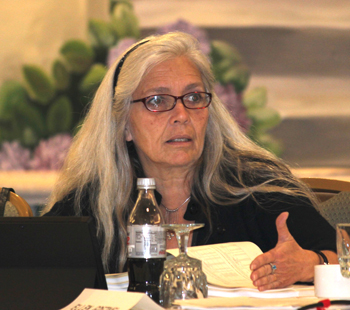Emergency Suspension of Observers Requested
continued from August 2015 Homepage

Ellen Goethel, NEFMC member. “Last week, the co-op told the fishermen not to go out, because they were getting 40 cents per pound for fish that they were paying over $1 per pound to lease. That brings us a grim picture of what the fishery is going through.” Fishermen’s Voice photo
monitoring in 2010, through Amendment 16 of the groundfish management plan. The program is used to verify areas fished, and landings and discards by species and gear type, for the purpose of monitoring sector quota.
Up to now, NMFS has been assuming those costs.
Goethel said the cost is coming at a time when there were no earnings.
“Last week, the co-op told the fishermen not to go out, because they were getting 40 cents per pound for fish that they were paying over $1 per pound to lease,” Goethe said. “That brings us a grim picture of what the fishery is going through.”
One groundfisherman said there has been little quota trading over the past two months. “Last year, we’d be buying fish into December, January, February, in Southern New England,” he said. “No one’s doing that. No one’s spending money this year because they’re potentially tying up in August and not paying the at-sea monitoring going forward.”
Northeast Fisheries Science Center (NEFSC) economist Chad Demarest said there’s no clear picture of what the fishery might look like if the industry is required to pick up observer costs.
“It’s clear the industry
can’t afford this cost,
not today, not tomorrow,
probably not for at least
several years.”
– Maggie Raymond,
Associated Fisheries of Maine
“As long as the returns are non-zero and positive, there will be a fishery. If there’s money to be made, somebody’s going to make it,” Demarest said. “But it does seem like the fishery’s going to look a lot different.” At-sea monitoring is only part of a complex picture that includes variabilities in the various fish quotas, the limits that one quota can place on the entire fishery, and assessments unable to keep up with the status of each groundfish stock.
“Until you have 18 stocks all simultaneously healthy, it’s hard to imagine how we’re going to get out of this,” Demarest said. “I think the fishery will look a lot different. I just can’t predict what that will look like.”
According to NMFS estimates, at-sea monitoring would cost fishermen in the groundfish sectors $710 per day and would result in roughly 60 percent of vessels operating with negative returns in the groundfish portion of their business. From 2010 to 2014, about 40 percent of vessels have operated with negative returns in the groundfish portion of their business. The increase is indicative of a forecast for substantial reductions in profit margins due primarily to the reduction in Gulf of Maine cod allocations hitting smaller inshore Gulf of Maine vessels most directly, according to NMFS. Those vessels could account for more the 40 percent of total at-sea monitoring costs while accounting for only 28 percent of total gross revenues.
That scenario indicates that industry-funded at-sea monitoring could result in restructuring of the fleet, although changes are hard to predict since at least parts of the fishery have remained active despite negative returns, NMFS said.
The industry cost estimate of $710 per day doesn’t reflect costs paid by the government for observers, such as data processing and administration.
The observer program is used to obtain information about the fishery.
“What’s going to happen if we don’t have this information coming into the system?” Maggie Raymond, of the Associated Fisheries of Maine, asked rhetorically. “My response is, you won’t have that information because half the fleet is going to tie up in August. So whatever you thought was important for the balance of this fishing year to aid in the assessment is likely to be drastically affected anyway, because people simply will not be able to go to work. It’s clear the industry can’t afford this cost, not today, not tomorrow, probably not for at least several years. It was assumed we would be financially viable by the time this bill came around, but that did not come true.”
Representatives of several environmental organizations said that, while they understood concerns regarding the cost of the program and the industry’s ability to pay, those concerns didn’t warrant suspending the at-sea monitoring program.
“It’s a critical component of the sector monitoring program approved in Amendment 16,” said Geoff Smith, the Gulf of Maine Program Director with the Nature Conservancy. “Getting rid of it will undermine the sector management system. Having a quota-based fishery with very few input controls and no good accountability on the other end is a recipe for disaster.”
Oceana northeast representative Gib Brogan agreed. “When things are depleted, as they are now, you need better information, not worse….There’s no wriggle room for error with Gulf of Maine cod. Overfishing is a reality.”
Goethel pointed out that, while the industry has been aware of the impending requirement to pay for observers, it was undercut by unexpected and extremely low fish allocations for Gulf of Maine cod and by the status of a number of other groundfish stocks.
“It’s the cuts in cod and other species, on top of this new cost, that makes it absolutely unbearable for the industry to continue,” said Goethe. “We’ve got guys who have started tying up already.”
NEFMC said that, if the emergency request is denied, it would ask NMFS to change the program in the current fishing year to reduce some of the financial burden on the industry.
